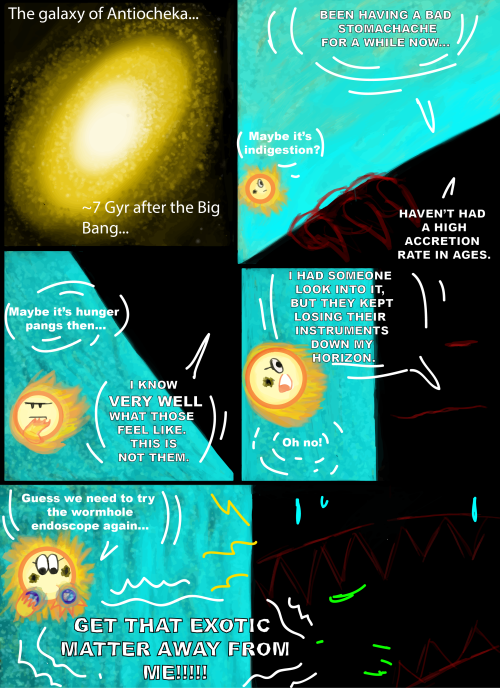EVEN THE BLACK HOLES ARE GETTING SICK NOWI cannot settle on a format for my comics, and I keep exper
EVEN THE BLACK HOLES ARE GETTING SICK NOWI cannot settle on a format for my comics, and I keep experimenting with new designs. Here, gravitational wave speech is depicted in speech bubbles that are empty and ripple-shaped. Electromagnetic wave speech is still depicted in regular speech bubbles.This comic takes place several billion years after most of the comics with Stella and Tartarus (which take place ~3 billion years after the Big Bang). This has given Stella plenty of time to learn how to perceive and create gravitational waves to a great degree, and so she speaks to Tartarus in his native gravitational language instead of the light-based language of stars.Now, a supermassive black hole normally has a temperature an insanely tiny fraction of a degree above absolute zero, so 10 Kelvins would actually be a very high temperature for Tartarus to run, even though to us that is barely any heat at all. As for what is causing Tartarus to feel sick? I’m not entirely sure, but probably some causality-violating eldritch abomination went down the wrong way, instead of being destroyed in the all-consuming hellfires/macerators/trash compactors that are black hole singularities. Don’t worry too much about Tartarus though…he’ll probably end up burping a couple of times and then somehow feel better.===============Some additional notes for curious people:-The ‘wormhole endoscope’ Stella refers to is the process of dropping one mouth of the wormhole into Tartarus, while she looks through the other end of the wormhole that is still above his event horizon. If you could create a wormhole (already a big if) you could potentially use this to peer inside a black hole until the moment the mouth you dropped in hits a singularity. You do need to make sure the end you’re looking through is in free fall, though, otherwise the wormhole will collapse due to the relative time dilation between the two mouths. During the process, the black hole’s event horizon temporarily deforms quite drastically due to the unusual energy densities one would need to build a wormhole, which is why Tartarus is very reluctant to undergo the procedure.(If you have a university internet/VPN you can find this here: https://journals.aps.org/prd/abstract/10.1103/PhysRevD.48.1607)-In the first panel, the galaxy of Antiocheka is depicted as a giant elliptical galaxy. This is because the host galaxies of quasars that existed in the early Universe are generally thought to eventually become what we see in the modern Universe as giant elliptical galaxies at the centers of galaxy clusters. In most of the comics I show with Tartarus and Stella, Antiocheka is younger and still has plenty of star formation. By the time 7 billion years have passed since the Big Bang, however, giant elliptical galaxies have stopped forming stars for the most part. Antiocheka will continue to grow by absorbing other galaxies in its cluster that fall into it, but there will not be any bright blue massive stars or colorful nebulae. -Tartarus has a low mass accretion rate here, as is standard for supermassive black holes at the centers of giant elliptical galaxies, so his accretion disk is optically thin enough to see hints of the galaxy’s stars through it. -- source link
#webcomic#black hole#astrophysics#astronomy#science#physics#sunlike star#accretion disk#elliptical galaxy#wormhole#hawking radiation

